There’s been a lot of hype around chatbots in the staffing industry over the last two or three years. HR professionals who always strive to make their candidate experience better, see chatbots as a status quo disrupting technology that can dramatically improve hiring efficiency for any business.
But are recruitment chatbots a real game-changer? In this blog post, we will explore all the advantages of this automation tool and walk you through possible use cases for HR chatbots. You will get a bunch of examples and tips, and learn how to build a chatbot with SendPulse.
Press /start to continue. 😉
Why use HR chatbots?
A chatbot is an automated service that helps you conduct online conversations via text or voice messages. Businesses integrate them into their websites, social media, and messengers to stay connected with their prospects, leads, and customers 24/7.
Chatbots can be rules-based or powered by AI. Rules-based bots use keywords and are faster to implement and train. They work like tree menus that you can personalize to meet your needs.
AI-powered bots use natural language processing (NLP) and machine learning. They bring more value in the long term, as they learn from each person they interact with. However, they are harder to build and require coding skills as well as experience with UI/UX design.
Both rules-based and AI chatbots help HR professionals communicate with job seekers, employees, and accomplish lots of time- and energy-consuming tasks.
Here are some of the tasks a chatbot can help HR professionals with:
| Recruitment |
Employee relations |
| Collecting applications |
New hire orientations and onboarding |
| Pre-screening |
Knowledge database and FAQs |
| Navigation and answering FAQs |
Event management and training |
| Interview scheduling |
Engagement surveys |
Hiring new talent can be costly and challenging for any business. Big companies like Google and Apple spend lots of time sifting through thousands of applications, while no-name employers struggle to get noticed and attract a sufficient pool of candidates to choose from.
The magic of recruitment chatbots is the fact that they help in both cases. No matter how big or small your business is — whether you’re hiring locally or prepping for global expansion — they can be used at different stages of the hiring funnel to make your recruitment more efficient.
Time to hire is a recruiting metric that answers the question of how long the hiring process takes from posting a job until a person gets on board. Measured in days, time to hire usually depends on the number of applicants at the top of the funnel and the speed they pass through it.
Recruitment chatbots ensure a broader reach and fuel the hiring process by interacting with potential candidates 24/7 on different channels and platforms. Apart from that, they increase conversions from stage to stage, facilitating the application and interviewing process.
Here are some stats from the Phenom Chatbots for Recruiting Benchmarks Report. It turns out that career page visitors leave their contact details and convert into leads twice as often if there is a chatbot instead of a static form.
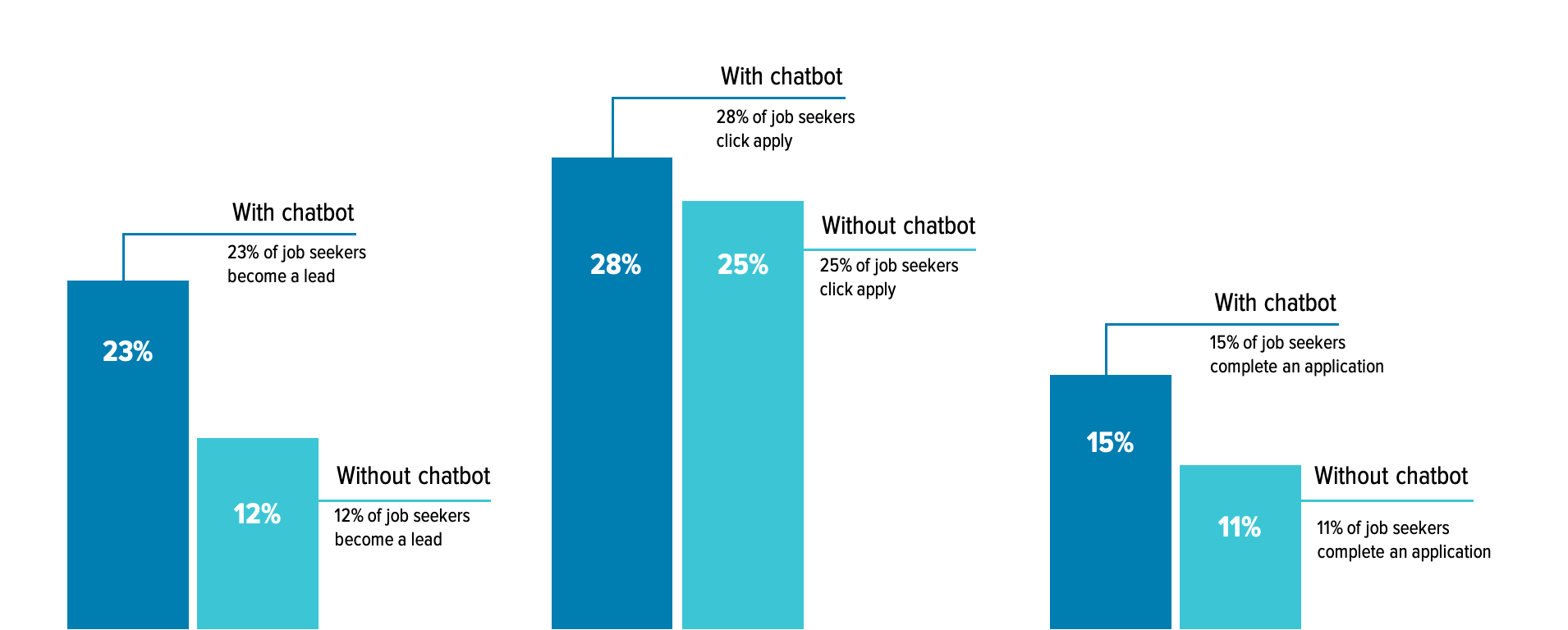 Source: Phenom chatbots for recruiting benchmarks report
Source: Phenom chatbots for recruiting benchmarks report
Let’s look at a case study to illustrate this: Deutsche Telekom designed a recruitment chatbot to improve their candidate experience. As a result, they reached a 15% visitors to applicants conversion rate, which is above average. 65% of all the questions the bot answered were asked outside business hours. Deutsche Telekom shows us that chatbots give you the flexibility to gather more applicants, more often.
Chatbots make your employer brand stronger
Using HR chatbots can have a positive impact on the employer brand: fewer applicants are left without a reply. Their positive candidate experience can boost word-of-mouth recommendations. Besides, chatbots are a perfect tool to voice your brand’s values and tease some of the perks of working at your company.
Using a chatbot for recruiting, you get a chance to beat the competitors and win the best talent not only in your current tasks but also in the long run. So, don’t be afraid to delegate and let a chatbot do the job.
Five tasks a recruitment chatbot can spare you from
There are several repetitive and time-consuming recruitment tasks that can be easily performed by HR chatbots. Have a look at each of them and grab some easy-to-implement best practices.
Collecting applications
One of the biggest hurdles to creating a good candidate experience is having to complete an application form. It is stressful not only because the forms are lengthy, but mainly because there are lots of forms to fill out when actively searching for a job. Job seekers do it over and over again, applying through different interfaces.
So, there is lots of space to make a difference: a chatbot for recruiting can replace this exhausting procedure with an engaging conversation that takes place in a cozy and habitual environment.
This is how Shamrock Foods Company collects applications on its careers website. When you first enter, you see an invite to talk to a recruiting assistant in the corner of the page. The assistant has a name and a friendly photo. Apart from collecting the contact data, this bot also verifies phone numbers.
Shamrock Foods Company career site chatbot
In the example below, a chatbot informs potential applicants about the freeze recruitment process status and collects contact information so HR and recruiters can get in touch with the candidates later.
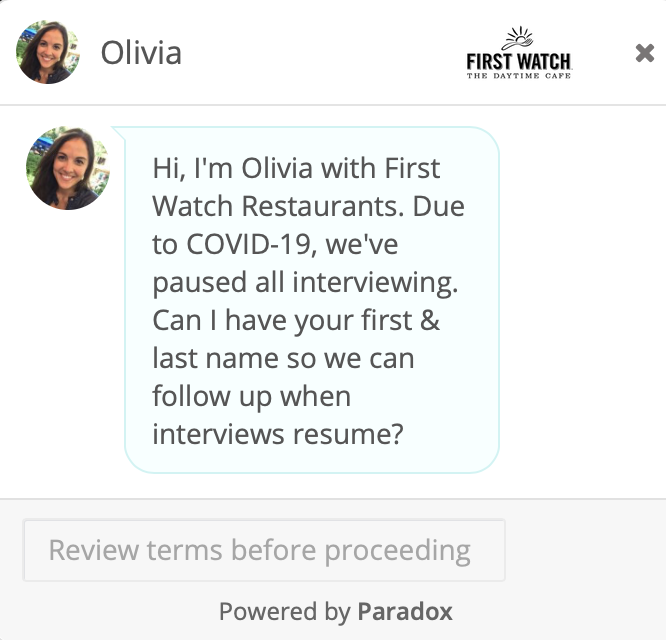 First Watch chatbot informing visitors about their recruitment freeze
First Watch chatbot informing visitors about their recruitment freeze
Apart from replacing the forms, recruitment chatbots digitize and streamline applications you normally get offline.
Imagine that you have an offline store or office. To speed up hiring, you would probably advertise your vacancy online and offline by placing printed job ads or application forms in your physical location. But how many people are ready to react and fill out the form in writing?
To make it easier for potential applicants, you can make QR codes linked to your recruitment chatbot or use tablets and hiring kiosks that allow people to interact with the bot right away on location.
Don’t forget that your recruitment bot will make the first impression, so design it in line with your team’s culture and values. If you hire hospitality professionals — show you care. If you are searching for somebody to work at your law firm, demonstrate your reputation and expertise. If you are looking for interns, be cheerful and fun.
Pro tip: Give your bot a name, use GIFs and emoji when appropriate. If you make people smile, it will build a positive association with your brand and encourage bot users to finish the process.
Pre-screening
If there is a large number of people applying for a job and you don’t have the capacity to look through all the applications, you might be missing some gold-level applicants. A chatbot for recruiting will pre-screen candidates so that you don’t miss out and can get in touch in-person with applicants who fit the bill.
When creating a pre-screening chatbot, make tailored scenarios for different types of applicants. For example, you can ask your potential employees to record a video with a motivational speech or complete an entry test. And when it comes to high-demand IT professionals: wouldn’t it be reasonable to spend more time describing your benefits rather than asking questions? Create several flows fit for all the candidate profiles you expect to hear from.
In the following example, a recruitment chatbot for the IT company segments the applicants according to their job profile and location:
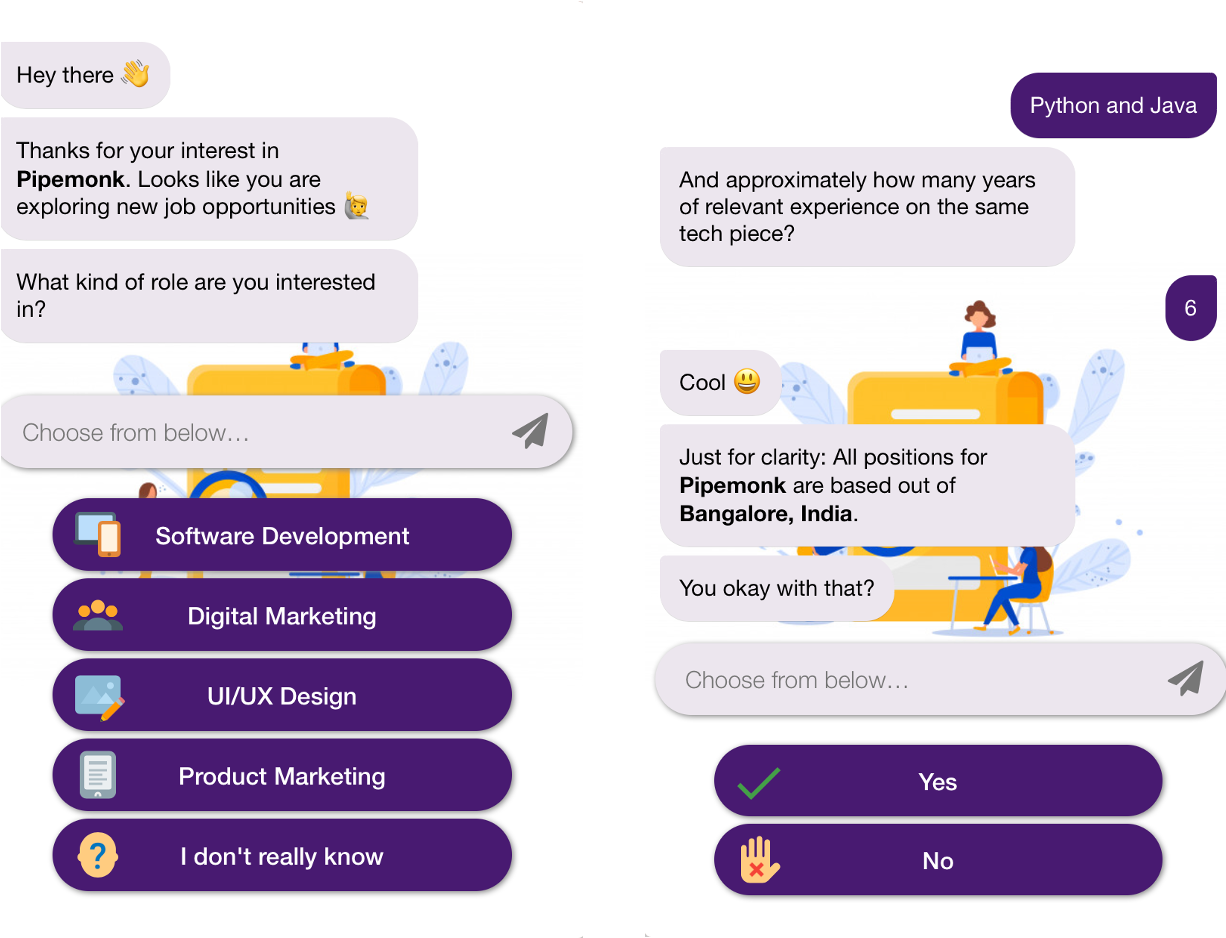 A pre-screening recruitment chatbot for Pipemonk
A pre-screening recruitment chatbot for Pipemonk
Pro tip: Don’t program your chatbot to refuse a candidate right away. Even if a person doesn’t meet some of your requirements, consider finishing the dialogue in a friendly manner and offer to keep in touch. People don’t expect to get rejected by a robot.
Some HR chatbots can be integrated with Applicant Tracking Systems (ATS). ATS is a perk that saves you lots of time because applications go directly to your candidate database, get scored, and distributed through the hiring stages.
For example, job seekers that don’t qualify can go directly to the “Decline” stage and those who are suitable for the job, proceed to the “Interview” stage. You can further automate the process and launch trigger email notifications to move on through the stages.
Navigation
Even if you are not ready to delegate pre-screening to a chatbot, you can still use it to route your job seekers to the right place or resource. This is how Microsoft uses a Facebook Messenger recruitment chatbot to route traffic to their career page:
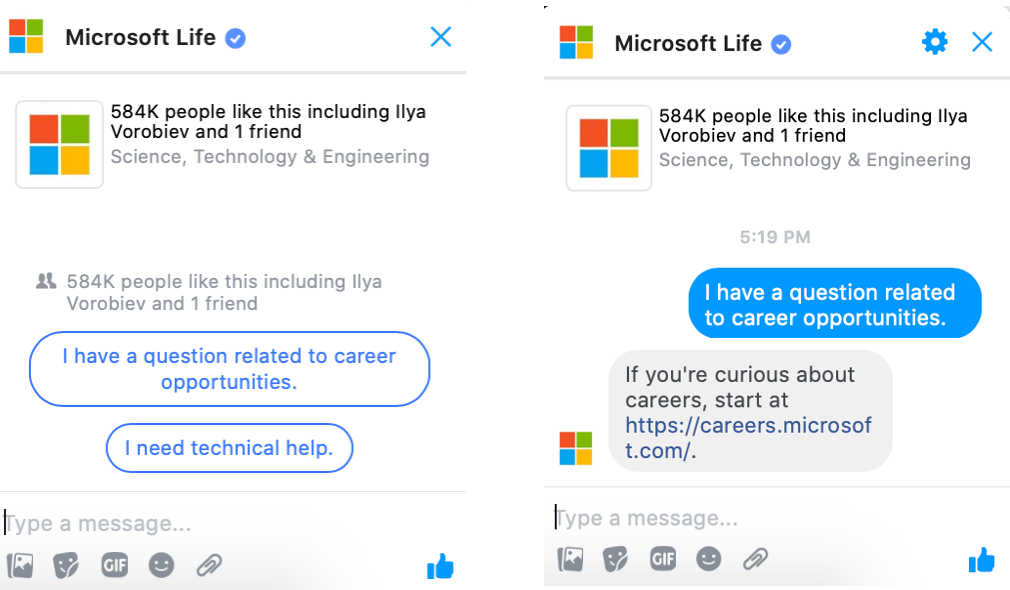 Microsoft Life Facebook Messenger navigation chatbot
Microsoft Life Facebook Messenger navigation chatbot
Answering FAQs 24/7
Candidates have all sorts of questions and want to know about the brand and culture, salary and benefits, location and structure, dress code, and policies. A recruitment chatbot can answer the most repetitive questions and help cut the time for queries.
For instance, the U.S. Army created the SGT STAR FAQ chatbot to answer the questions of the recruitees: how to enroll, what’s the salary, how to enlist and join the army reserve. This bot was created back in 2006 because of the increased recruitment traffic after 9/11. Originally implemented as a cost-cutting measure, it is still up and running.
 SGT STAR U.S.Army bot used to answer frequently asked questions
SGT STAR U.S.Army bot used to answer frequently asked questions
Here is another example of a FAQ bot used for executive search. It answers all the questions about the company and lets users request a callback.
 Salveson Stetson Group FAQ chatbot
Salveson Stetson Group FAQ chatbot
Interview scheduling and reminders
As per Cronofy Interview Scheduling Survey, 56% of recruiters spend more than a full working day scheduling interviews for vacancies. More than 60% of recruiters say that interviews clash with other commitments.
Chatbots connected to a recruiter’s calendar offer appointment slots so that job seekers can schedule interviews on the fly. This spares lots of time that is usually spent on:
- searching the best date and time;
- resolving commitment clashes and rescheduling;
- avoiding time zone conflicts.
Chatbots can also solve the problem of no-show interviews. Applicants who didn’t show up for the interview are the ones who make recruiters “cry” most of the time. With all the energy invested, no-shows are the most disappointing. Chatbots can send automated reminders and navigate job seekers to your office, helping you avoid no-shows.
Georgia State University uses a recruitment chatbot to manage the process of students’ enrollment: to send timely reminders and relevant information about the enrollment process, collect key survey data, and answer questions around the clock. As a result, they got a 3.3% increase in enrollment and a 21.4% reduction in summer melt.
Here is an example of an HR chatbot integrated into Google Calendar. Apart from booking appointments, it offers calendar invitations and notifications.
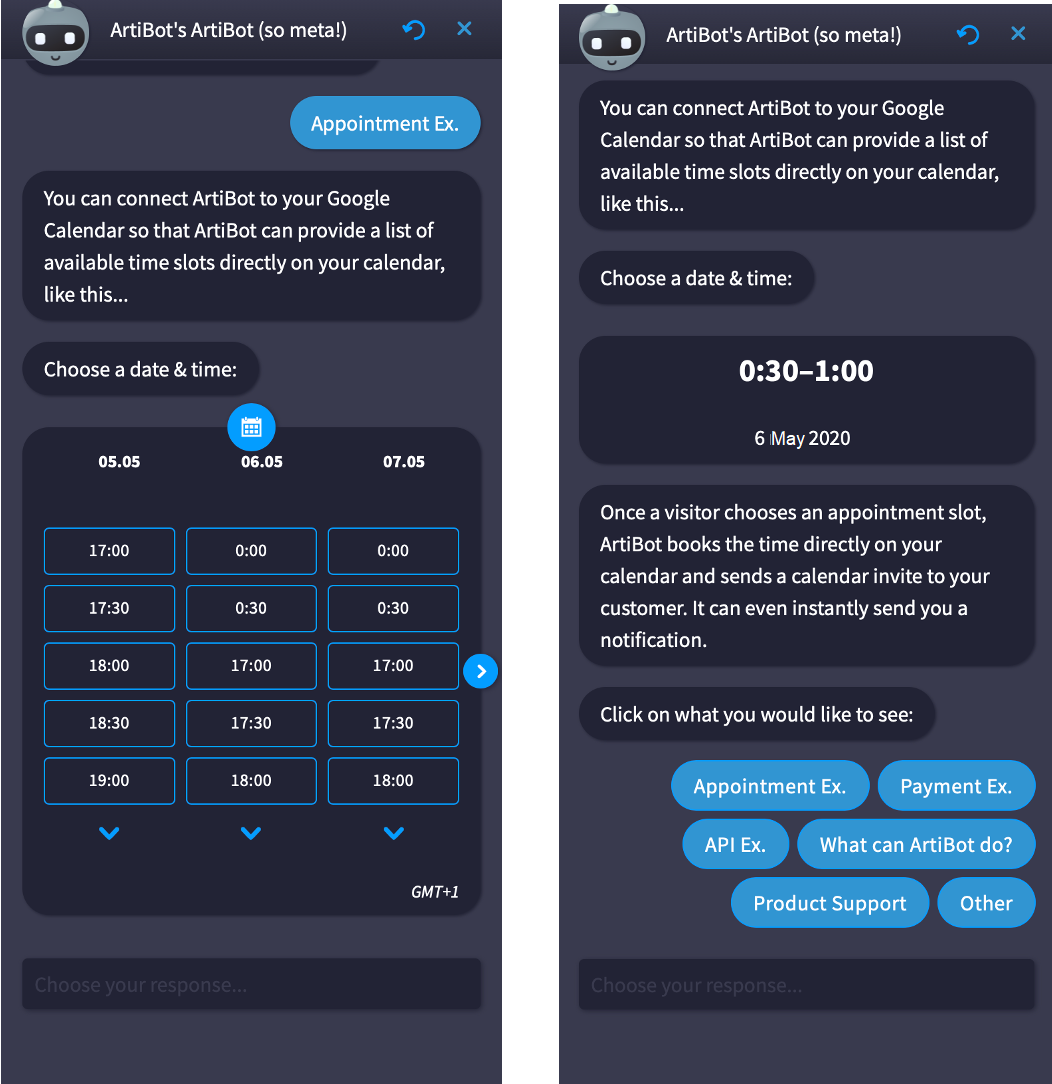 ArtiBot’s interview scheduling feature
ArtiBot’s interview scheduling feature
How to build a recruitment chatbot with SendPulse
With SendPulse, you can build Facebook and Telegram chatbots for most of the scenarios. Don’t worry, you wont need IT guys to help you: the chatbot builder is easy to use.
Tip: Before you go to the SendPulse chatbot builder, map out the process you want to automate — otherwise, you are at risk of losing lots of time playing with visual elements. Draw a scheme on a piece of paper or use a mind mapping tool, taking into account all the job requirements and contact info you need to collect.
Imagine you have a boutique software development company in Europe that is always in search of cool IT professionals and interns. Your biggest ambition is to build a solid candidate database to be able to nurture it and hire faster. So, you need a chatbot for recruiting and collecting applications online.
Let’s build a Telegram recruitment chatbot together because that’s where your target audience spends time. Here’s how an overall flow in SendPulse may look:
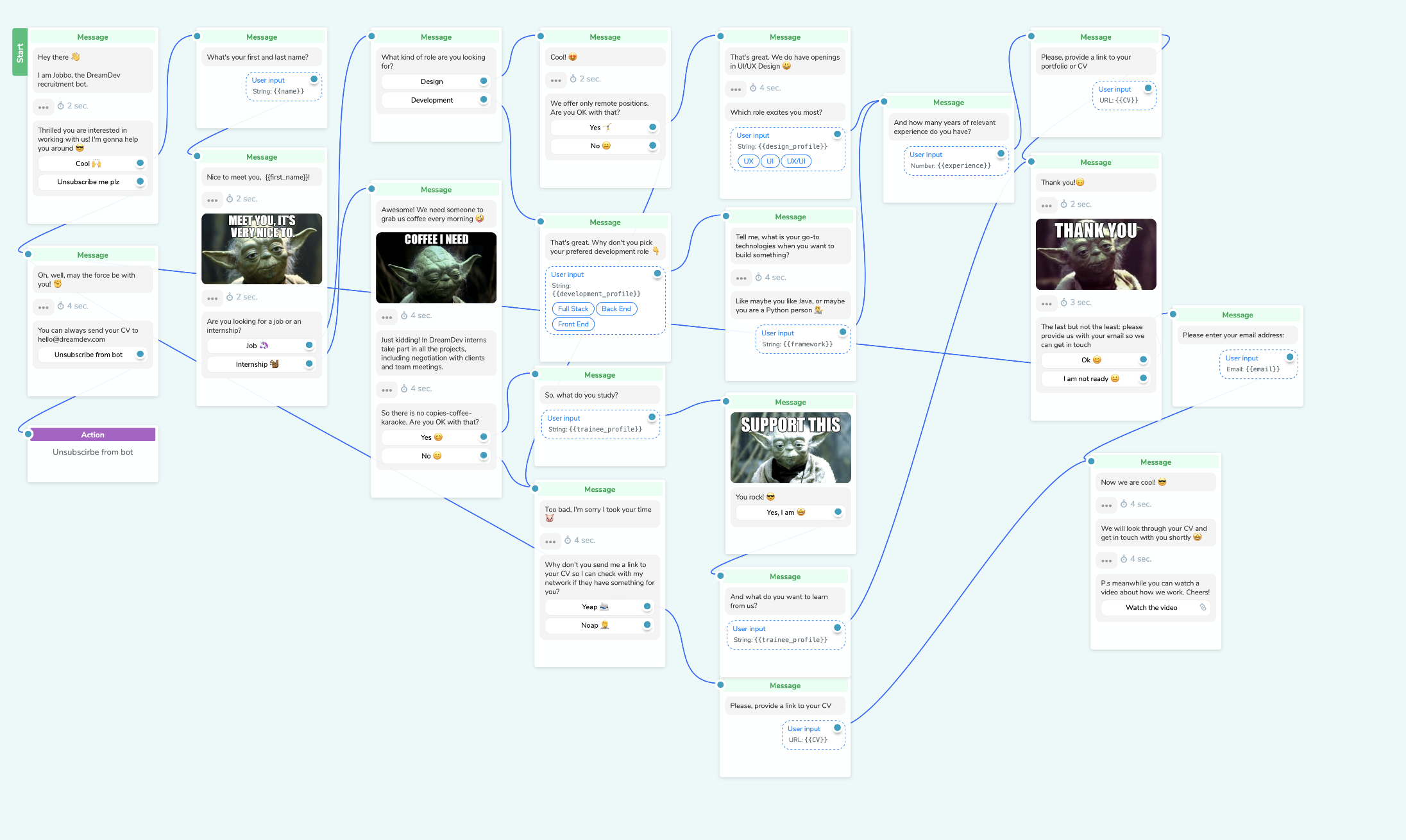 Recruitment chatbot flow for Telegram built with SendPulse
Recruitment chatbot flow for Telegram built with SendPulse
This simple chatbot offers two main flows: internships and jobs. The jobs flow is split into Development and Design categories. Let’s look at these flows closer.
Internship recruitment chatbot flow
In this flow, you can collect contact information and clarify the motivation of potential interns. The qualifying questions are:
- What’s your name?
- Where do you study?
- What do you want to learn from us?
Tip: Make sure you meet personal data collection requirements and add this step into the flow even before asking for your visitor’s name.
This is how the internship recruitment chatbot flow looks in the chatbot builder:
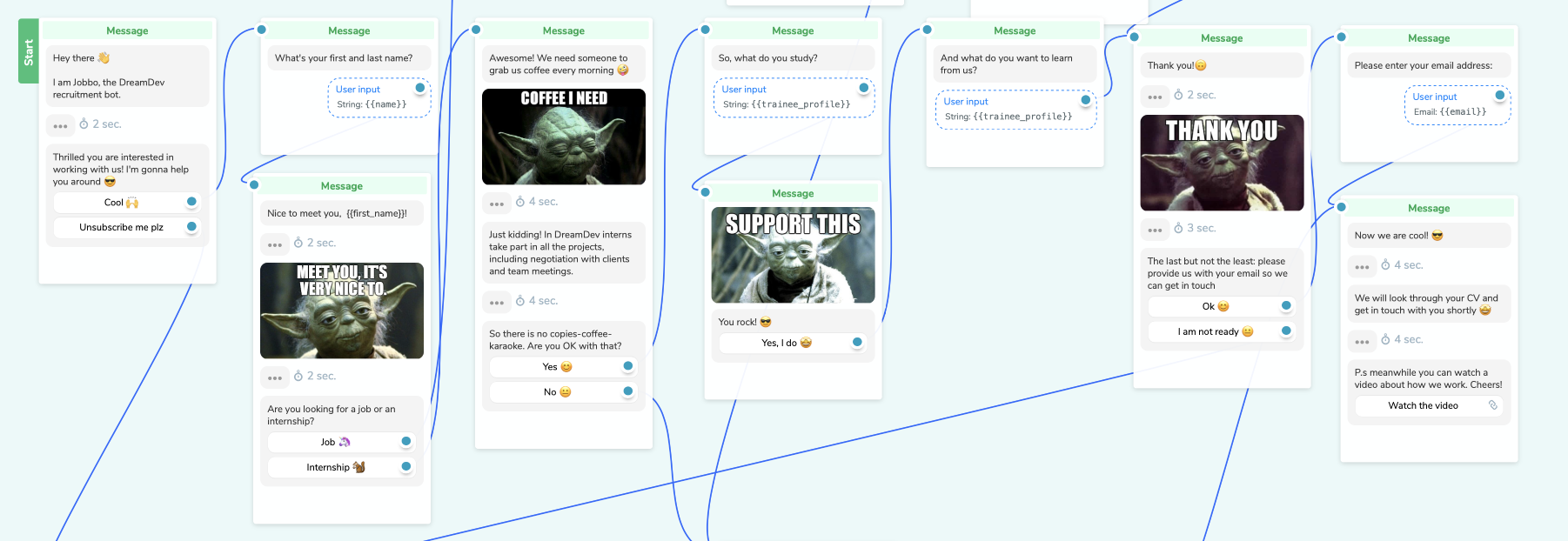 Internship recruitment chatbot flow
Internship recruitment chatbot flow
Here you can use yes-no questions with buttons and direct input questions to ask applicants about their place of study, motivations, and interests. You can also ask them to provide a link to their CV and provide an email address to be used as the main contact method.
To make the interaction more engaging, use emoji and images, or jokes when appropriate.
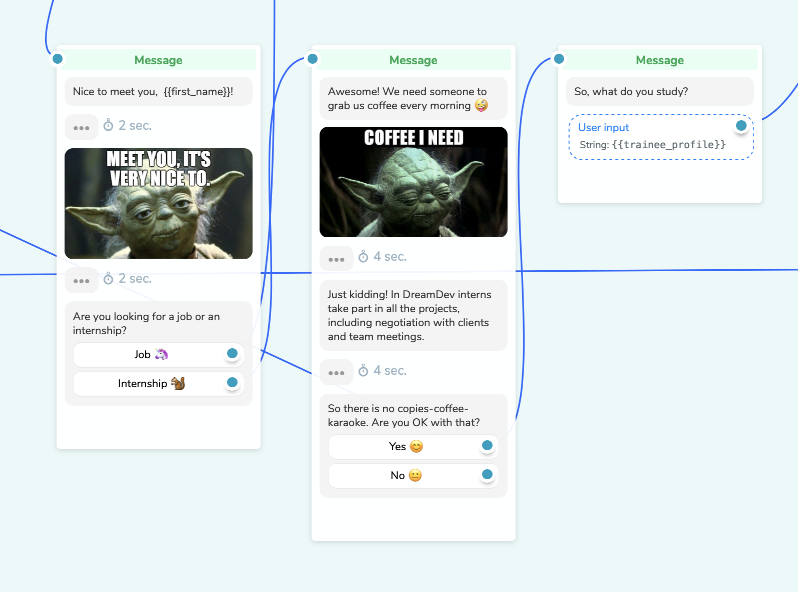 Images and emoji used in the internship recruitment chatbot flow
Images and emoji used in the internship recruitment chatbot flow
Don’t forget that your visitors may not be willing to provide their information or lose interest in the recruitment chatbot despite your efforts, that’s why your flow should include a “Back to main menu” or “Unsubscribe” button.
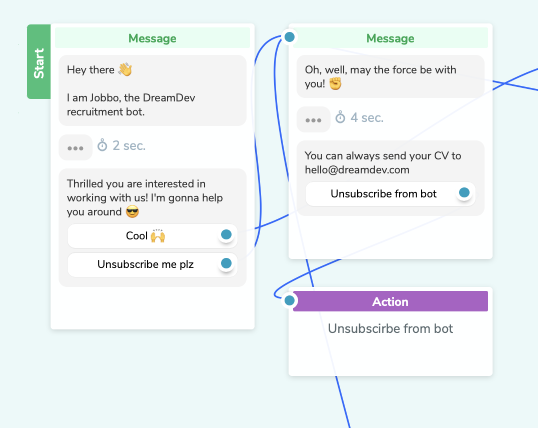 Unsubscribe flow in SendPulse
Unsubscribe flow in SendPulse
This is how this flow works in Telegram:
Interacting with a recruitment chatbot created with SendPulse
Full-time job recruitment chatbot flow
We split the flow in two because our goal is to collect the applications for designer and developer positions:
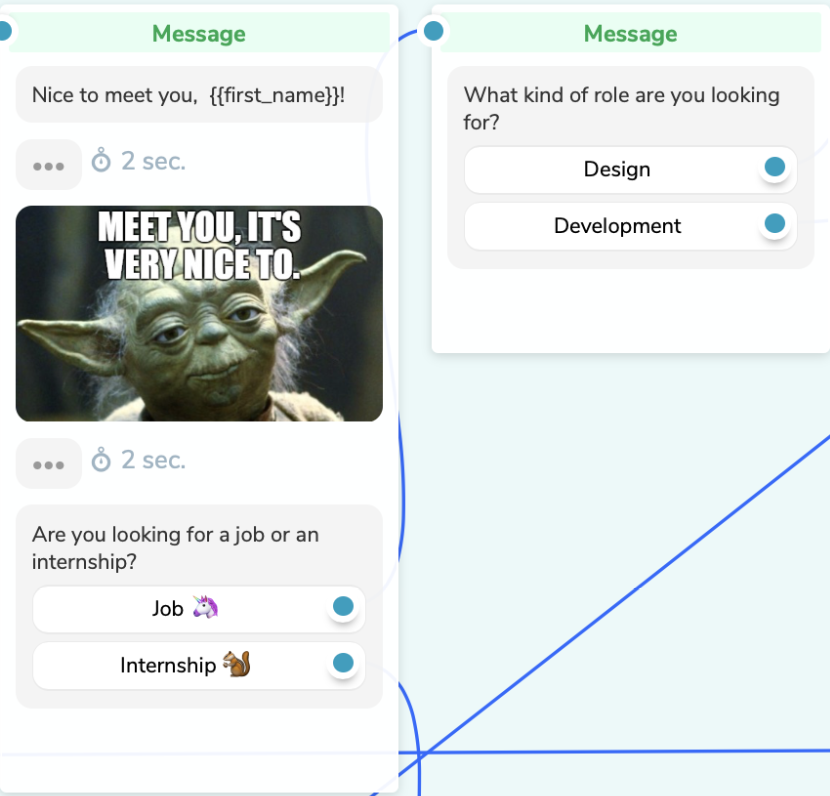 Splitting the chatbot flow in two
Splitting the chatbot flow in two
We have two subflows with specific qualifying questions each.
The Designer’s flow questions are:
- name;
- is it OK that the positions are remote;
- whether the applicant is experienced in UX, UI, or both;
- years of experience;
- CV and/or portfolio;
- email address.
The Developer’s flow questions are:
- name;
- development role: Full Stack, Back End, or Front End;
- which computer languages or frameworks they use;
- years of experience;
- CV and/or portfolio;
- email address.
This is how the Developer’s flow looks:
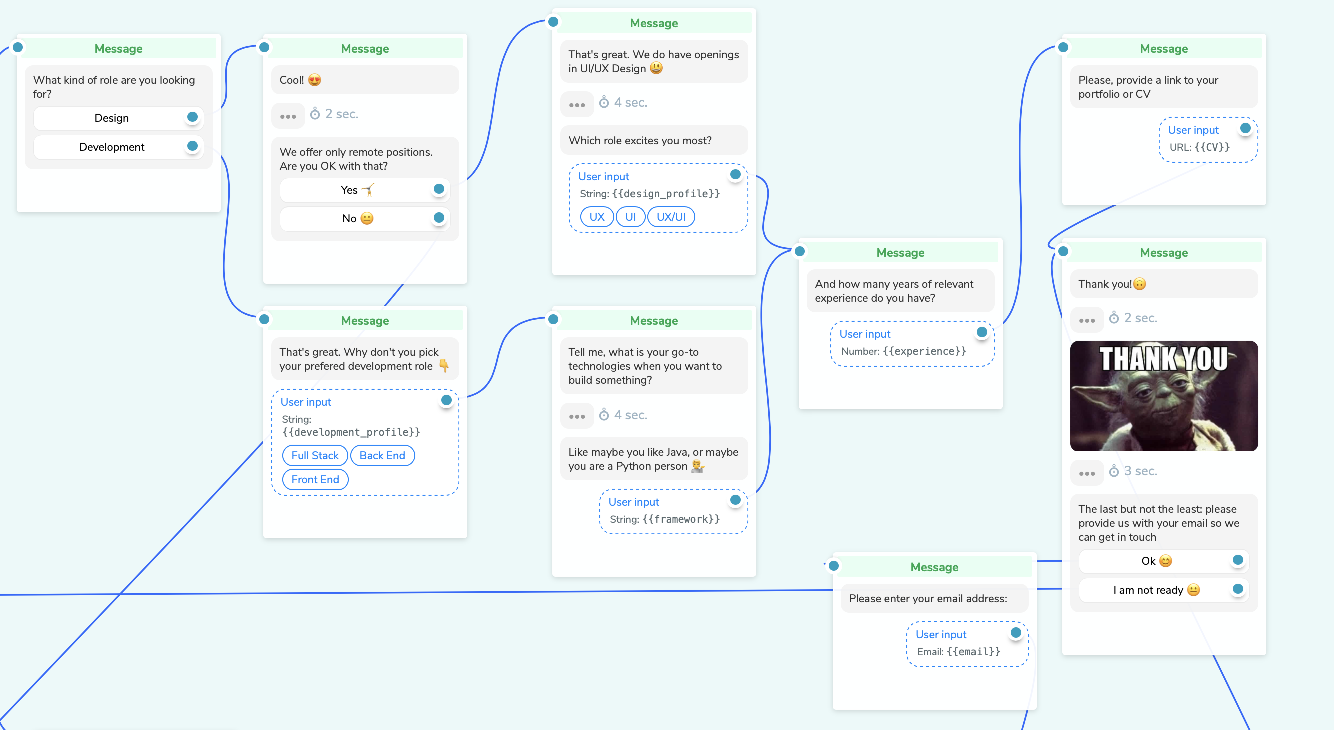 Recruitment chatbot flow for collecting applications
Recruitment chatbot flow for collecting applications
In the Developer’s flow, you can use direct input questions with quick answers so that applicants can easily understand your question and answer it easily.
 Quick answers in the Developer job application flow
Quick answers in the Developer job application flow
If the job you offer is remote, temporary, or has any other crucial specifics, make it clear for the applicant in the very beginning. Otherwise, your prospect is at risk of chatting with the bot in vain and being disappointed.
Tip: Place the contact information fields before any other questions to experiment with conversions. You will probably have more leads, but their quality cannot be guaranteed.
Here’s how the Designer’s flow works in Telegram:
Interacting with a recruitment chatbot in Telegram
The flow we showed is quite simple, you can use it as a foundation for various communication scenarios with job applicants and trainees and enjoy engagement and conversions.
To sum it up
Chatbots in the staffing industry is just what the doctor ordered: they can automate lots of routine tasks, reduce time to hire, and contribute to your employer brand.
Here are some tasks a recruitment chatbot can help you with:
- Chatbots can replace application forms and make the application process more engaging and even fun.
- Pre-screening chatbots can allow HR specialists to filter candidates so that a recruiter actually steps in only with the most qualified candidates.
- Chatbots can guide your applicants and answer FAQs 24/7.
- With chatbots, the interview scheduling process and reminders are no longer a nightmare.
Sign up with SendPulse and create Telegram and Facebook recruitment chatbots for free in a simple and entertaining manner.